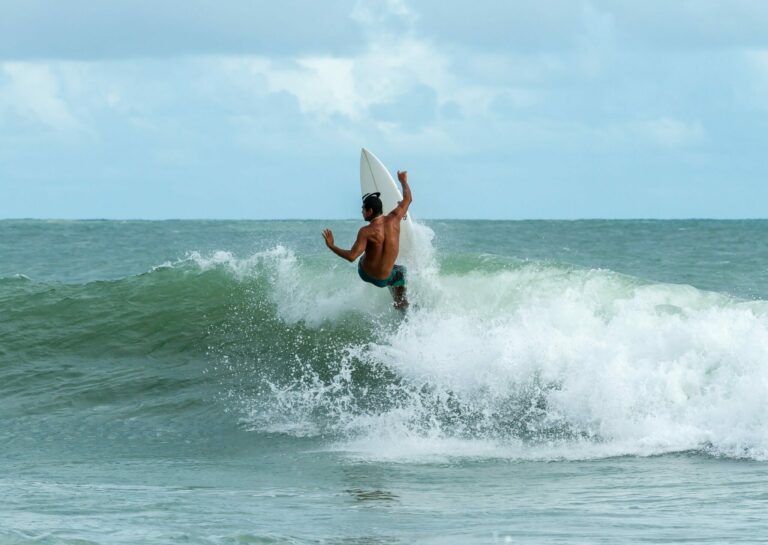Most Common Surfing Injuries and How to Avoid Them
Back in the day, surfers were bohemians, hair down to their shoulders, clad in nothing but old shorts. Shirts and shoes were for special occasions. They didn’t need them. Life played out in the sand and the water. All they needed was their board and the waves.
They lived to show off, perfect posture, always nimble. Arms and legs flexing as they rode the pipe. They bailed with style and played things off when they washed out. They knew people were watching.
They had to be courageous and walk it off. So what if they hit their heads or skinned their backs? They’d be alright. That was part of the fun. You’d just paddle back out and try again–brag about your scars when you were back on land. It was a blast–until medical science started advancing, and whispers spread throughout the surfing world.
We’d see veterans slip into a slump, pick up the bottle–worse, they’d hit a point where they couldn’t hang. They’d stop going out, grow long beards, stay at home, and one day we’d hear that they were gone. They’d take their own lives.
Then there were the dare devils, skilled artists who would conquer the real beasts, spending their days off of the coast of Hawaii, taking Portuguese storms like titans.
They’d bail one afternoon and wash up ashore, their heads covered in blood. It could take years for them to recover. They’d slur their words, use walkers, then pick up drinking. They’d drop off the scene, never to be heard from again.
We know what happens. We’ve seen the best of the best dragged out of the water in stretchers. We’d cover our mouths, shake our heads, and tell stories, then we’d get right back out there–wearing just a pair of old shorts, no shoes, board in hand. That’s how we paddled out.
Things are changing slowly. People are starting to talk. It’s time we addressed these issues, because the waves are not safe; what’s waiting at the bottom of the ocean has killed before, and it will kill again.
There are common injuries that can be avoided, and there are a few things that need to be made known. Surfing has always been dangerous, and it always will be. But we can make it safer.

Jorge Luis Perez / Flickr
Cuts
We don’t really think about it. We hit our foot against a rock or scrape a knee. That’s nothing right? When we paddle out, we immerse ourselves in water filled with all sorts of wild bacteria–some of it known to consume flesh. The sand is no better than the water itself. A marginally sized cut requires a hospital visit. A big cut means an immediate trip to the emergency room. Anything less could result in extreme infection, and at the very worst loss of limb.
A good wetsuit can help pad the body, making it difficult for rock and coral to pierce through. This should be a part of a surfer’s repertoire anyway. Water shoes are also a must. Coral and rocks are known to slice through feet. Water shoes can also help with grip, making it easier to stay on the board.
Always treat cuts. Learn to clean them, when to go to the hospital, and how to keep them covered. They need to be maintained.
Head Injuries
The world of surfing needs to take notice: wear a helmet. Protect your noggin. We all remember what it was like when we were kids riding our bikes around. There were guys with elbow pads, knee pads, wrist pads, and giant helmets, lumbering along, trying to stay upright. Everyone laughed at them, but when they fell, they didn’t feel a thing. It was the kids with no helmet that needed to watch out.
It’s the same with surfers. Everyone wants to show off and ride the waves; they don’t think about staying safe. Even professional surfers, the guys who ride 30-40 foot demons–they know the danger; they’ve had concussions; their friends have faced brain trauma, and they still don’t wear helmets. They’ll bash into rock and coral, let water crash down on them like mountains of brick, and keep going at it.
In recent years, imaging technology has shown us that small bumps build up over time, turning into concussions, then trauma, and eventually serious disorders. It’s vdifficult to understand the full effects. But we know that this can cause cognitive issues, chronic pain, and mental health issues. Addiction is par for the course. Older surfers are known to experience depression and suicidal ideation. People watch as they change. It alters their personalities. Some pro surfers are starting to speak out, but not enough. We can’t go by their example.
The only way to avoid head trauma is to wear a helmet every time you go out on the water. That is essential, because if you’re hitting your head at all, you’re doing damage.

Surfer’s Ear
Over time cold water and wind can cause bony growths to build up inside the ear canal. This is called exostoses, and it can trap water inside your ear, leading to partial hearing loss and infection. Solve this problem before it starts by wearing ear plugs. There are some amazing designs on the market, and they’ll help you avoid painful treatment down the road.
Muscle Strain and Cramps
There’s nothing worse than cramping up or straining a muscle when paddling out. In order to ensure your safety, it’s best to make sure that your basic muscle groups are well honed. Exercise, stretch, and always make sure you’re hydrated.
Know the Game and Know the Limits
Before you go out to surf, you should assess the water, the weather, and the lay of the land. Know where the riptides are. Know where to paddle out, and try to get a feel for the underwater conditions. There might be rocks, coral, and kelp. Find them so you can adjust your course accordingly.
Also know what you’re doing. Be sure that you are prepared for the waves you take on. Don’t go past your basic limitations. If you really want to up your game, find a good instructor, someone who can show you the ropes. We can’t always go it alone.




